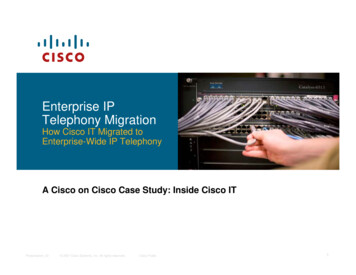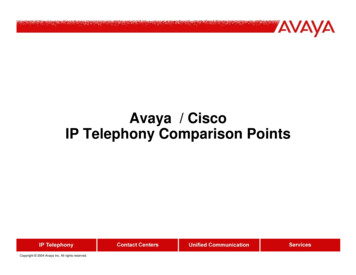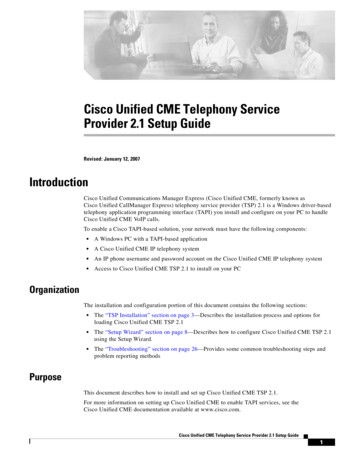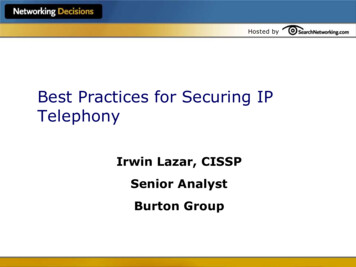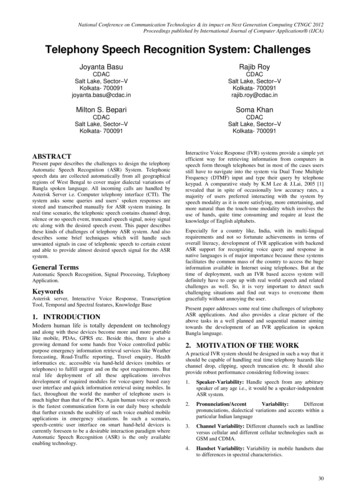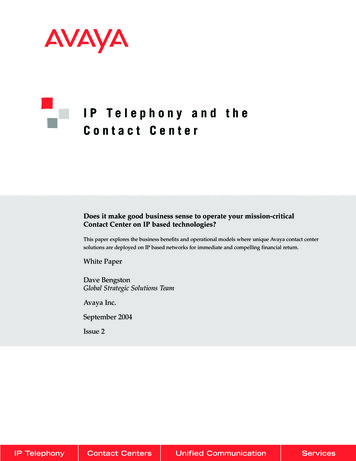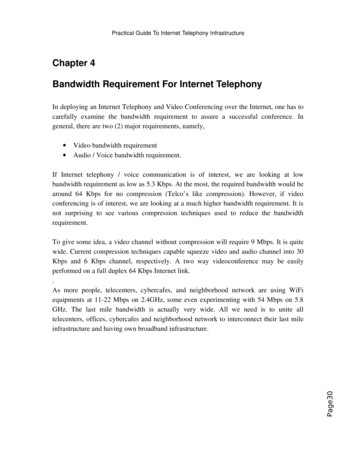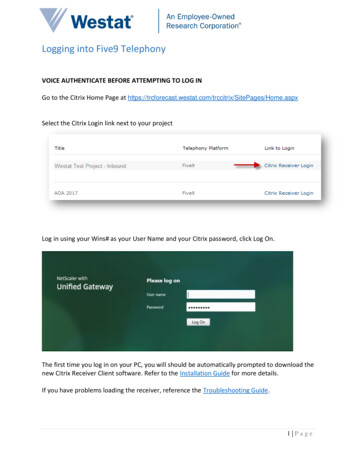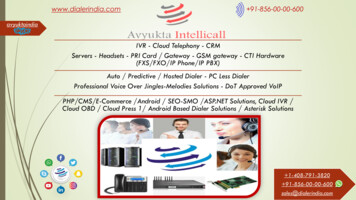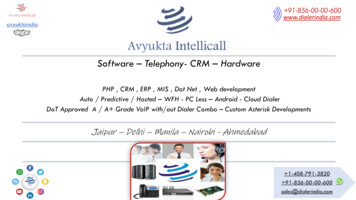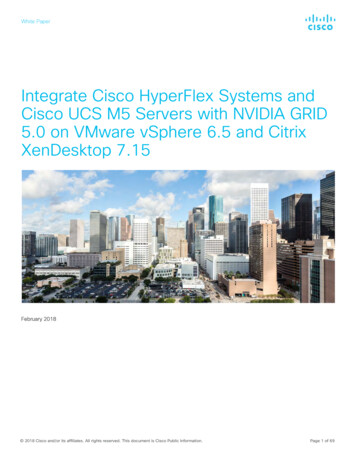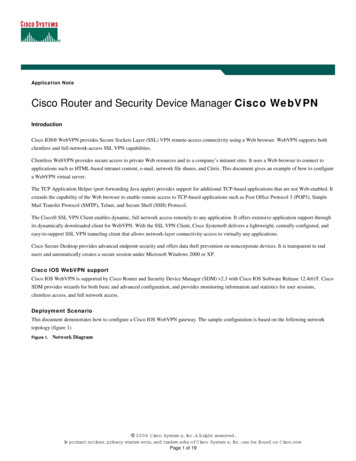
Transcription
IP Telephony:Cisco’s Approach toROIRod MurphyMAM Cisco Atlantic 2000, Cisco Systems, Inc.1
Agenda Convergence the basis of ofthe business Solution Benefits ROI Centralized Calling Real examples of ROI 1999, Cisco Systems, Inc.2
Convergence is. the merger of the physical infrastructureand the applications that run on thatinfrastructure for enhanced communicationsand connectivity.ARPANetWWWMulticast/Video E-CommerceConvergenceToday 1999, Cisco Systems, Inc.3
The Future of Telephony “The buzz at VoiceCon, of course, was aboutIP telephony in general and IP-PBXs inparticular. And what was new was that thereare no longer any nay-sayers among theequipment vendors. None - and I meanNONE -- of the PBX vendors have a nextgen, circuit-switched, TDM product in thepipeline. They are all betting their futures and their customers' - on packetized voice.BCR, March 1999, Cisco Systems, Inc.”4
Next Generation CommunicationSolution Benefits Enhanced productivityNew apps and services for individuals, workgroups Lower total cost of ownershipReduced capital layout in new sitesBig operational savings over timeStandards based infrastructure hardware Generate sustainable competitive advantageSuperior customer serviceFaster speed to market Operational agilityReduced time to add new users and servicesUbiquitous access to services for all usersSmooth migration path New levels of scalabilitySame technology scales from 10 to 100,000 users & multiple sites 1999, Cisco Systems, Inc.5
Why Cisco IP Telephony? Cost Savings Scalability Increase Productivity Mobility Choice Innovative Business Applications 1999, Cisco Systems, Inc.6
Reason #1: Cost savings Reduced Capital Expenditure & Lower Operational CostsConverged InfrastructureToll Bypass savingsBandwidth efficienciesOne wire to the desktopQuicker and Easier DeploymentIP LAN mean Low Cost Moves, Adds and ChangesWeb based Management - local or remote 1999, Cisco Systems, Inc.7
Maximizing the Return on“Network” InvestmentTo maximize the return on “network” investmentcompanies must: Lower the cost of “network” ownershipReduce overall network infrastructure costsReduce application integration costsReduce ongoing network administration costsVoice Health Monitor 1.0, QPM 2.1and SMS 2.0Fully leverage existing network investments Enhance business communications to create strategic valueImprove employee productivityIncrease Knowledge SharingEnhance customer serviceEnable employee mobility 1999, Cisco Systems, Inc.8
Cray Inc. ROI Case Study Deployment DetailsROI CalculatorGlobal market leader in high-endsupercomputersMulti-site deploymentReplaced existing PBX with IP Telephony650 phonesRequired data network upgrade to handletime-sensitive voice traffic ROI FindingsPayback—7 monthsROI Drivers:Cost of Cisco IP Telephony and data gearcost the same as PBXImproved productivity of network supportstaff by 33%Reduced MAC’s costs by 30K/yearReduced inter-office calling charges by 25K/year 1999, Cisco Systems, Inc.Summary Sheet9
Centrex Case ExampleThe Cash Flow Schedule Deployment Details Existing facility with modest annualemployee growth that wanted to movevoice in-house 1000 Centrex Lines @ 16/line/month Analysis includes costs of data networkupgrade ROI Findings Payback – 22 months ROI Drivers Eliminated monthly Centrex line costs Reduced MAC’s costs by 30K/year Reduced inter-office calling chargesby 25K/year 1999, Cisco Systems, Inc.10
General ROI Findings The range of observed paybacks falls between immediate to 4 yearswith the average being approximately 16 months The principle ROI drivers are determined by a customer’s ownunique circumstances, however we have seen some consistent ROItrendsRapid Payback ScenariosVariables Effecting Speed of Payback§New facility§Speed of Migration§End-of-life for existing PBX inconjunction with a planneddata network upgrade§Remaining lease life on PBX§Multiple branch officesconverting to a centralized callprocessing model§Ability to quantify strategicvalue of converged network§Extent of data upgrade§Centrex Replacement 1999, Cisco Systems, Inc.11
Integration/Interoperability PBX & key systems Centrex Existing WANs PSTN Voice Messaging Systems MS Exchange environments 1999, Cisco Systems, Inc.12
Centralized CallProcessing Overview2823 04 2001 X 2001,2000, Cisco Systems, Inc.13
What Is CentralizedCall Processing Cisco CallManager serversand applications serverslocated atcentral site Routing, switchingand IP phones onlyat branch office IP WAN used for call setup Local trunking at remotesites (typically) 1999, Cisco Systems, Inc.VBranch14
Old World Telephony at theSmall Branch Office PBXs deployed at large sites, key switchesat small sites Small site key switches do not offer all the featuresavailable in a large site PBX Small sites typically have nonredundant hardware,leading to potential long outages in case of failure There is limited or no feature interoperabilitybetween key switches and PBXs. As a result,branch office users are not as integrated withthe rest of the organization Users in small sites are prioritized lower whenrolling out new applications across the enterprise 1999, Cisco Systems, Inc.15
Benefits of CentralizedCall Processing Give remote users full enterprise—level featuresets across telephony applications, instead ofreduced capabilities (PBX vs. key system) Does not require IT staff at each remote site Deploy telephony to remote sites at a fraction ofthe time it takes for PBX or key systems Ability to rapidly deploy new productivityapplications to remote users Easy upgrades and maintenance Distributed call processing is still a useful andsupported configuration 1999, Cisco Systems, Inc.16
Centralized Call ProcessingKey Drivers Simplify managementReduce capital expendituresReduce maintenance costsReduce overall total cost ofownership Seamless WAN connectivityof all branch sites(toll bypass savings) Single unified dial plan andone single network Greater scalability 1999, Cisco Systems, Inc.17
Why go IP for Voice? Improved productivity, more cost effectiveadministration Open interfaces for integration Multi-site, multi-vendor Application provider choice Scalability/End user personalization Drives quick-to-market New World applications Mobility - User and application geographicindependence 1999, Cisco Systems, Inc.18
2000, Cisco Systems, Inc.
reduced capabilities (PBX vs. key system) Does not require IT staff at each remote site Deploy telephony to remote sites at a fraction of the time it takes for PBX or key systems Ability to rapidly deploy new productivity applications to remote users Easy upgrades and maintenance Distributed call processing is still a useful and
